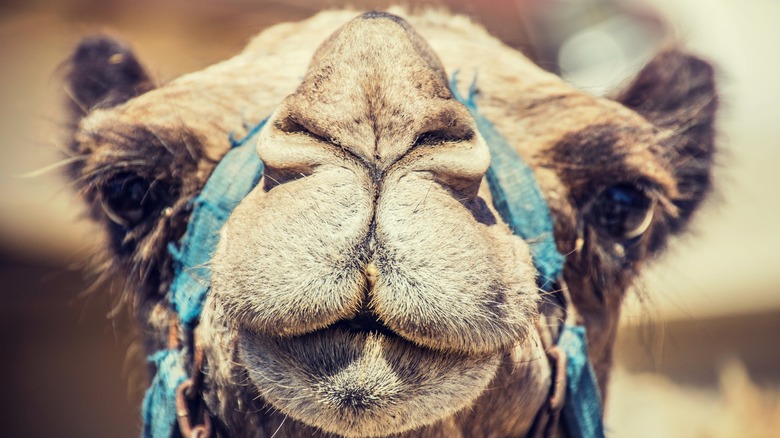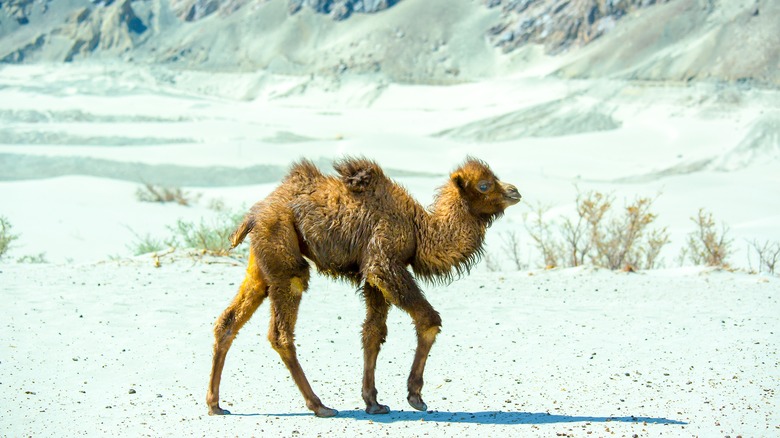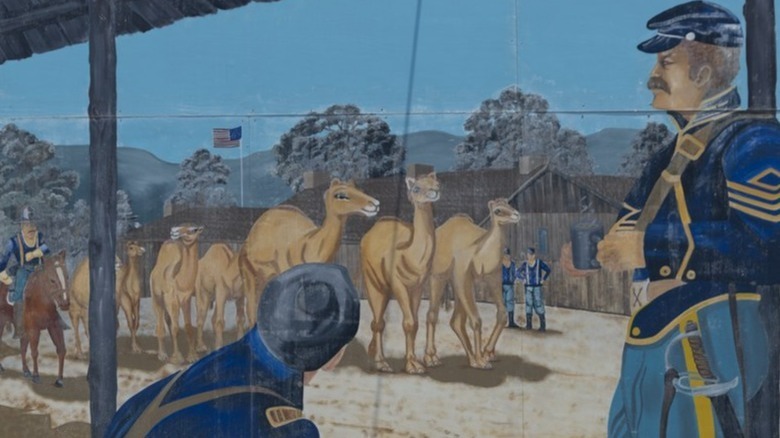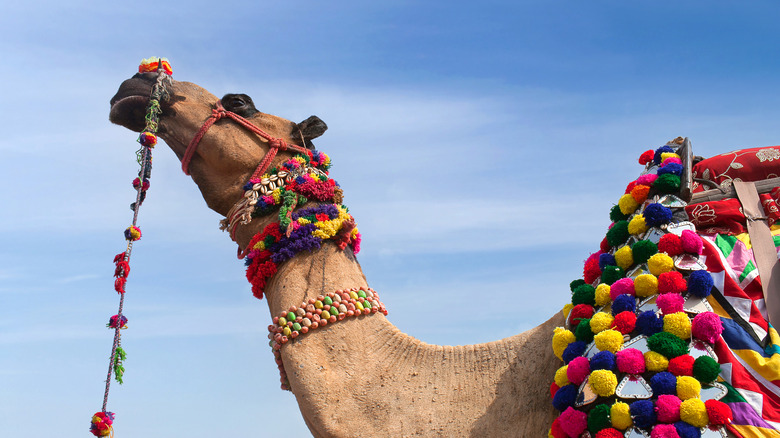The Surprising History Of Camels In North America
Though the idea of camels generally conjures scenes from Arabian caravans or an oasis in the desert, camels once roamed across the Americas, just as they do in Africa and Asia. While there aren't any more of these majestic creatures in the wilds of North America today, they have a fascinating history on the continent.
Many natural historians believe that camels actually originated in North America. According to Interesting Engineering, it is currently believed that camels roamed North America an eye-watering 40 million to 50 million years ago. That means that camels were around for as much as 48 million years before the first human ever existed (per History).
Those same scientists have estimated that it wasn't until 3 million years ago that camels made their way across the Bering Strait via the land bridge that once connected Alaska to Russia. It was this migration that brought camels to Asia and Northern Africa, the two places perhaps most associated with the majestic animals today.
The origin of camels gets weirder
What is even more extraordinary is that recent discoveries have suggested that camels weren't just relegated to one area of North America — they spread all over vastly different terrains. For example, construction workers building a freeway in San Diego unearthed camel fossils in 2020, per The San Diego Union-Tribune. The fossils have since been dated to be around 15 million years old and suggest that the animals once happily lived in the area now claimed by the popular California city.
Camel fossils have also been found in what is almost the total opposite terrain from San Diego. In 2006, archaeologists found a camel skeleton on Canada's Ellesmere Island, located in the northernmost part of Canada and neighboring Greenland. As part of the arctic archipelago ring, the geography of Ellesmere Island can be described as snowy and mountainous with a jagged coastline. Many refer to the terrain on the island as the "horizontal Himalayas," according to The New World Encyclopedia. That said, the fossils showed that the camel was a whopping nine feet tall, so it remains unknown exactly how this species had adapted to survive in the vastly different land type.
The sad fate of the native camel
Sadly, exact details surrounding the specific biology of the North American camel remain somewhat a mystery, as the animals died out around 11,000 years ago. This corresponds to when humans first made their way to the Americas, suggesting that perhaps they were hunted into extinction, not unlike the fate that almost befell the American bison in the late 19th century. Experts have estimated that around one-eighth of some early Native American diets consisted of camel meat, according to Smithsonian Magazine.
That said, some scientists have suggested that the mammals died out less because of human overkill, but because of geological changes that occurred when the planet adjusted from a glacial climate to an interglacial one, per The Proceedings of the National Academy of Sciences. Whatever the reason, the camel was not able to survive.
However, that doesn't mean that remnants of the camel and its history haven't made their mark on the Americas. According to National Geographic, llamas, alpacas, guanacos, and vicuñas of South America were all descended from the camel. Moreover, camels were to have a small resurgence in North America later in history — but for a different reason entirely.
The U.S. Army's bizarre camel corps
Though most Americans know Jefferson Davis as the president of the Confederacy, he had a long career in Washington before the Civil War — including holding the position of the Secretary of War under President Franklin Pierce. During that time, the United States was in the midst of a fervor known as Manifest Destiny, the belief that it was the country's fate to expand so that its borders reached from coast to coast.
That meant conquering land that had unique geological obstacles, such as the arid deserts in the American Southwest. Davis thought that camels would be key to tackling the difficult terrain, and convinced Congress to appropriate $30,000 for "the purchase and importation of camels and dromedaries to be employed for military purposes," per Smithsonian Magazine.
By 1857, the U.S. had procured 75 camels and had stationed them at Camp Verde in central Texas. Incredibly, the scheme started off extremely well. One of their first assignments was to use half the herd for an expedition to California led by Edward Fitzgerald Beale. This mission was a huge success, despite significant challenges: traveling more than 1,200 miles through mostly barren countryside during the summer. "He had accomplished what most of his closest associates said could not be done," according to a paper in the California Historical Society Quarterly (posted at the University of California Press).
The legend of the Red Ghost
Though the use of camels in conquering the Western frontier had a promising start, the advent of the Civil War in 1861 changed everything. The United States government was more interested in using its troops and resources for battle than exploration. Moreover, most of the camels were stationed in Texas, which was a confederate state. Though one camel was reportedly used by the 43rd Mississippi Infantry during the Battle of Vicksburg, most "were turned loose to graze and some wandered away," documented a 1909 edition of Popular Mechanics.
Though some camels made their way down to Mexico, others continued to roam across the American southwest for the next few decades. One particularly fierce camel created its own myth. Known as the "Red Ghost" due to its auburn fur, this feral camel reportedly terrorized parts of Arizona in the 1880s. According to Smithsonian Magazine, lore claimed that the Red Ghost was 30 feet tall and had fatally trampled a woman in 1883. It also allegedly nearly killed a cowboy and his horse and even supposedly "devoured" a grizzly bear.
While those may be tall tales, there is some truth to the creepiness surrounding the legend. Smithsonian says that when the Red Ghost was finally killed, The New York Sun reported that "strips of rawhide [were] wound and twisted all over his back, his shoulders, and even under his tail." In other words, someone (or something) had once been lashed and bound around the creature until its death.
Is there a 'Camel King' in the future?
Today, experts estimate that there are fewer than 3,000 camels residing in the United States. Though many of those are in zoos or circus acts, a vast majority are actually held by private individuals, not unlike the enthusiasts who were documented in the hit Netflix series "Tiger King." But while big camels may not have quite the same mass appeal as big cats, it appears that camel-obsessed individuals are just as fervent in their passion.
Per a report by The University of London, most of the nation's present camel population is owned by a select group of 20 or 30 people with special interest in the creatures. Herds vary in size — anywhere from eight to 80 — and are kept on private game ranches. However, the paper noted that the true camel population in the United States remains unknown, as no registries have been established due to "infighting among the various camel interests." With talk of "infighting" and "camel interests," perhaps a murder-for-hire plot in the camel community isn't too outlandish a thought after all.





